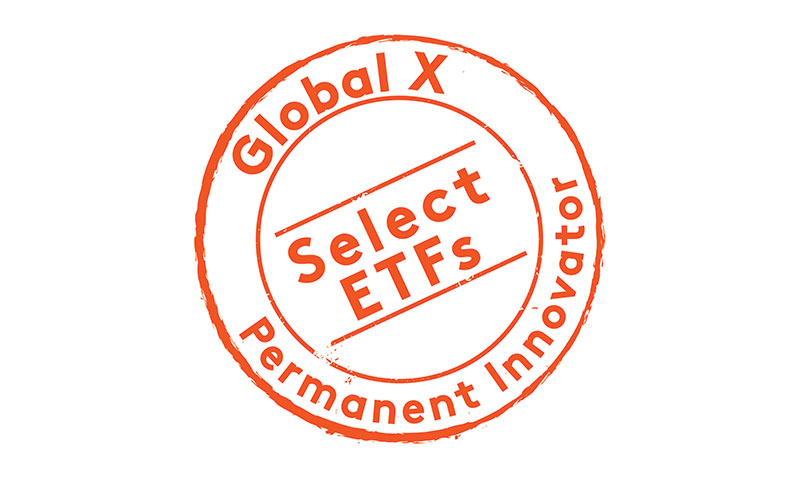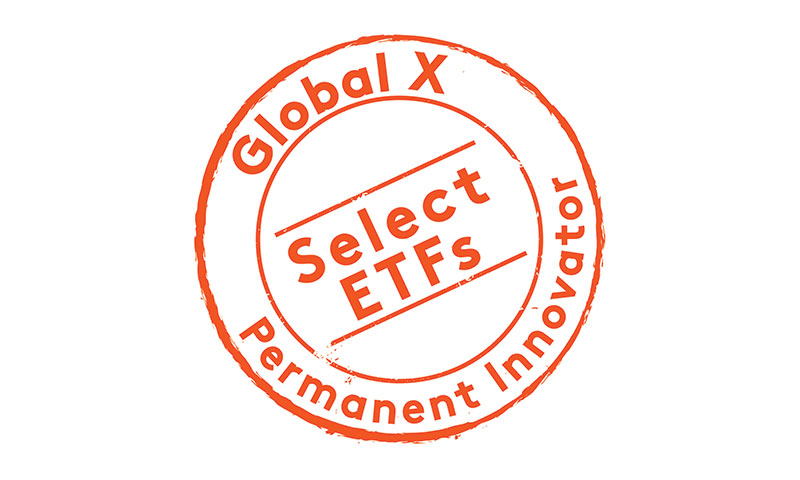Important Information
Investors should not base investment decisions on this material alone. Please refer to the Prospectus for details including the product features and the risk factors. Investment involves risks. Past performance is not indicative of future performance. There is no guarantee of the repayment of the principal. Investors should note:
- The investment objective of Global X China Semiconductor ETF’s (the “Fund”) is to provide investment results that, before fees and expenses, closely correspond to the performance of the FactSet China Semiconductor Index.
- The Fund is exposed to concentration risk by tracking a single region or country.
- The Index constituents may be concentrated in a specific industry or sector, which may potentially more volatile than a fund with a diversified portfolio.
- Semiconductor industry may be affected by particular economic or market events, such as domestic and international competition pressures, rapid obsolescence of products, the economic performance of the customers of semiconductor companies and capital equipment expenditures.
- Investment in Emerging Market, such as A-share market, may involve increased risks and special considerations not typically associated with investments in more developed markets, such as liquidity risk, currency risks, political risk, legal and taxation risks, and the likelihood of a high degree of volatility.
- The Stock Connect is subject to quota limitations. Where a suspension in the trading through the Stock Connect is effected, the Sub-Fund’s ability to invest in A-Shares or access Mainland China markets through the programme will be adversely affected.
- Listed companies on the ChiNext market and/or STAR Board are usually subject to higher fluctuation in stock prices and liquidity risks, over-valuation risk, differences in regulation, delisting risk, and concentration risk.
- There are risks and uncertainties associated with the current Mainland China tax laws, regulations and practice in respect of capital gains realized via Stock Connect on the Fund’s investments in Mainland China. Any increased tax liabilities on the Fund may adversely affect the Fund’s value.
- The trading price of the Fund’s unit on the SEHK is driven by secondary market trading factors, which may lead to a substantial premium or discount to the Fund’s net asset value.
- The Fund’s synthetic replication strategy may invest up to 50% of its net asset value in financial derivative instruments (“FDIs”), which may expose the Fund to counterparty/credit risk, liquidity risk, valuation risk, volatility risk and over-the-counter transaction risk. The Fund may suffer losses from its usage of FDIs.
- The Manager may at its discretion pay dividends out of the capital of the Fund. Distributions paid out of capital, represent a return of an investor’s original investment or its gains and may potentially reduce the Fund’s Net Asset Value per Share as well as the capital available for future investment.
- The Fund may suffer from a losses or delays when recovering the securities lent out. This may potentially affect its ability to meet payment and redemption obligations. Collateral shortfalls due to inaccurate pricing or change of value of securities lent, may cause significant losses to the Fund.
- The investment objective of Global X Hang Seng TECH Covered Call Active ETF (the “Funds”) is to generate income by primarily investing in constituent equity securities in the Hang Seng TECH Index (the “Reference Index”) and selling (i.e. “writing”) call options on the Reference Indexes respectively to receive payments of money from the purchaser of call options (i.e. “premium”).
- If the value of the securities relating to the Reference Index held by the Fund declines, the premium that the Fund received for writing the Reference Index Call Option may reduce such loss to some extent. However, the downside of adopting a covered call strategy is that the Fund’s opportunity to profit from an increase in the level of the Reference Index is limited to the strike price of the Reference Index Call Options written, plus the premium received.
- The market value of an Reference Index Call Option may be affected by factors including supply and demand, interest rates. The Fund’s ability to utilise Reference Index Call Options successfully will depend on the ability of the Manager to correctly predict future price fluctuations.If an Reference Index Call Option expires and if there is a decline in the market value of the Reference Index during the option period, the premiums received by the Fund from writing the Reference Index Call Options may not be sufficient to offset the loss realised.
- The Reference Index Call Options in the OTC markets may not be as liquid as exchange-listed options. The Fund may find the terms of counterparties in the OTC markets to be less favorable than the terms available for listed options. Moreover, the SEHK may suspend the trading of options in volatile markets which may casue the Fund unable to write Reference Index Call Options at times
- The use of futures contracts involves market risk, volatility risk, leverage risk and negative roll yields and “contango” risk.
- Investing in Reference Index Futures and writing Reference Index Call Options generally involve the posting of margin. If the Fund is unable to meet its investment objective as a result of margin requirements imposed by the HKFE, the Fund may experience significant losses.
- The Fund employs an actively managed investment strategy. The Fund may fail to meet its objective as a result of the implementation of investment process which may cause the Fund to underperform as compared to direct investments in the constituent equity securities of the Reference Index.
- The Fund is exposed to concentration risk by tracking a specific regions or countries.
- To the extent that the constituent securities of Reference Index are concentrated in securities of a particular sector or market, the investments of it may be similarly concentrated.
- The trading price of the Fund’s unit on the SEHK is driven by secondary market trading factors, which may lead to a substantial premium or discount to the Fund’s net asset value.
- The Manager may at its discretion pay dividends out of the capital of the Fund. Distributions paid out of capital, represent a return of an investor’s original investment or its gains and may potentially reduce the Fund’s Net Asset Value per Share as well as the capital available for future investment.
- The Fund may suffer from a losses or delays when recovering the securities lent out. This may potentially affect its ability to meet payment and redemption obligations. Collateral shortfalls due to inaccurate pricing or change of value of securities lent, may cause significant losses to the Fund.
- The investment objective of Global X HSCEI Covered Call Active ETF (the “Funds”) is to generate income by primarily investing in constituent equity securities in the Hang Seng China Enterprises Index (the “Reference Index”) and selling (i.e. “writing”) call options on the Reference Indexes respectively to receive payments of money from the purchaser of call options (i.e. “premium”).
- If the value of the securities relating to the Reference Index held by the Fund declines, the premium that the Fund received for writing the Reference Index Call Option may reduce such loss to some extent. However, the downside of adopting a covered call strategy is that the Fund’s opportunity to profit from an increase in the level of the Reference Index is limited to the strike price of the Reference Index Call Options written, plus the premium received.
- The market value of an Reference Index Call Option may be affected by factors including supply and demand, interest rates. The Fund’s ability to utilise Reference Index Call Options successfully will depend on the ability of the Manager to correctly predict future price fluctuations.If an Reference Index Call Option expires and if there is a decline in the market value of the Reference Index during the option period, the premiums received by the Fund from writing the Reference Index Call Options may not be sufficient to offset the loss realised.
- The Reference Index Call Options in the OTC markets may not be as liquid as exchange-listed options. The Fund may find the terms of counterparties in the OTC markets to be less favorable than the terms available for listed options. Moreover, the SEHK may suspend the trading of options in volatile markets which may casue the Fund unable to write Reference Index Call Options at times
- The use of futures contracts involves market risk, volatility risk, leverage risk and negative roll yields and “contango” risk.
- Investing in Reference Index Futures and writing Reference Index Call Options generally involve the posting of margin. If the Fund is unable to meet its investment objective as a result of margin requirements imposed by the HKFE, the Fund may experience significant losses.
- The Fund employs an actively managed investment strategy. The Fund may fail to meet its objective as a result of the implementation of investment process which may cause the Fund to underperform as compared to direct investments in the constituent equity securities of the Reference Index.
- The Fund is exposed to concentration risk by tracking a specific regions or countries.
- To the extent that the constituent securities of Reference Index are concentrated in securities of a particular sector or market, the investments of it may be similarly concentrated.
- The trading price of the Fund’s unit on the SEHK is driven by secondary market trading factors, which may lead to a substantial premium or discount to the Fund’s net asset value.
- The Manager may at its discretion pay dividends out of the capital of the Fund. Distributions paid out of capital, represent a return of an investor’s original investment or its gains and may potentially reduce the Fund’s Net Asset Value per Share as well as the capital available for future investment.
- The Fund may suffer from a losses or delays when recovering the securities lent out. This may potentially affect its ability to meet payment and redemption obligations. Collateral shortfalls due to inaccurate pricing or change of value of securities lent, may cause significant losses to the Fund.
Global X ETFs Updates:
Navigating through Volatilities with Thematic Growth & Income
Hong Kong/China market volatility edged up as US-China tariff tension escalated. On 10 Oct, the US President Trump said he would impose an additional 100% tariff on Chinese products as well as export controls on “critical software” effective 1 Nov. China later warned that it will retaliate if Donald Trump fails to back down on his threat to impose 100% tariffs on Chinese imports. US market corrected substantially on the tariff turmoil last Friday. On Sunday afternoon (US time), Trump hinted that he may not follow through with his tariff threat, posting on Truth Social that “it will all be fine!”. US stock futures rises after the post. HK market corrected today with tech names led the decline. The increased volatility could also lead to some profit taking in the near term after substantial YTD rally in Hong Kong market.
Amid the market pullback, we see two key investment opportunities: 1) Buy-the-dip on China semi with Global X China Semiconductor ETF (3191/9191): market sell-offs create attractive entry levels for China semi names, as the incremental impact of further US restrictions is limited, while the momentum towards China’s semiconductor localization continues to strengthen; 2) Play defensive and capitalizie on volatility with Global X HSCEI Covered Call Active ETF (3416) and Global X Hang Seng TECH Covered Call Active ETF (3417): Amid market uncertainty, Covered Call ETF is a defensive tool for investors to diversify portfolio and capitalize on volatility.
Thematic Strategy: Buy the Dip on China Semiconductors Amid Heightened Geopolitical Tensions
China semiconductor stocks remained relatively resilient comparing to overall HK market. We believe recent geopolitical tensions are actively reinforcing the long-term localization trend of China semiconductor, making current market corrections an attractive entry point for investors.
We believe that China has upper hand in negotiations with the US. The additional 100% tariff would not deter China, as China can endure more prolonged pain than the US. This is primarily due to the crucial impact from China’s rare earth supply chain control. China not only dominates rare earth but also has a near-monopoly on processing industries, which would take years to replicate. Additionally, higher tariff would eventually impact US inflation, and US farmers’ outcry would provoke when China stopped buying soybean from the US.
We also see China semiconductor self-sufficiency trend is making progress and accelerating. Recent developments have intensified market sentiment on this trend. It started with reports that Nvidia had asked its suppliers to halt H20-related production, followed by DeepSeek’s new V3.1 model optimized for next-gen domestic AI chips, China’s ban on tech firms buying Nvidia’s AI chips, Huawei’s unveiling of an ambitious three-year AI chip roadmap, and SMIC’s testing of a Chinese-developed DUV lithography tool, underscoring the urgency and concerted effort to achieve semi self-reliance. We believe China’s journey toward semiconductor localization is a long-term structural trend.
The Global X China Semiconductor ETF (3191/9191) offers targeted exposure to the entire China semiconductor industry value chain. The product seeks to invest in companies involved in the production of semiconductors in China including companies whose principal business is related to integrated circuit design (fabless), manufacturing (foundry), packaging and testing (OSAT), and semiconductor production equipment (SPE).
Covered Call Strategy: Capitalizing on Market Volatility
Major source of income for Covered Call Strategy is option premium from selling call options. Option premium tends to increase in tandem with market volatility, making range-bound market a favourable market condition for Covered Call Strategy. Following the China market rally that ensued after the last round of US tariff threats in April, Hong Kong market volatility edged up in September, leading to higher option premiums. The uncertainty surrounding the latest round of tariff escalation at this stage may contribute to a sustained rise in market volatility, resulting in elevated option premiums for the Covered Call Strategy.

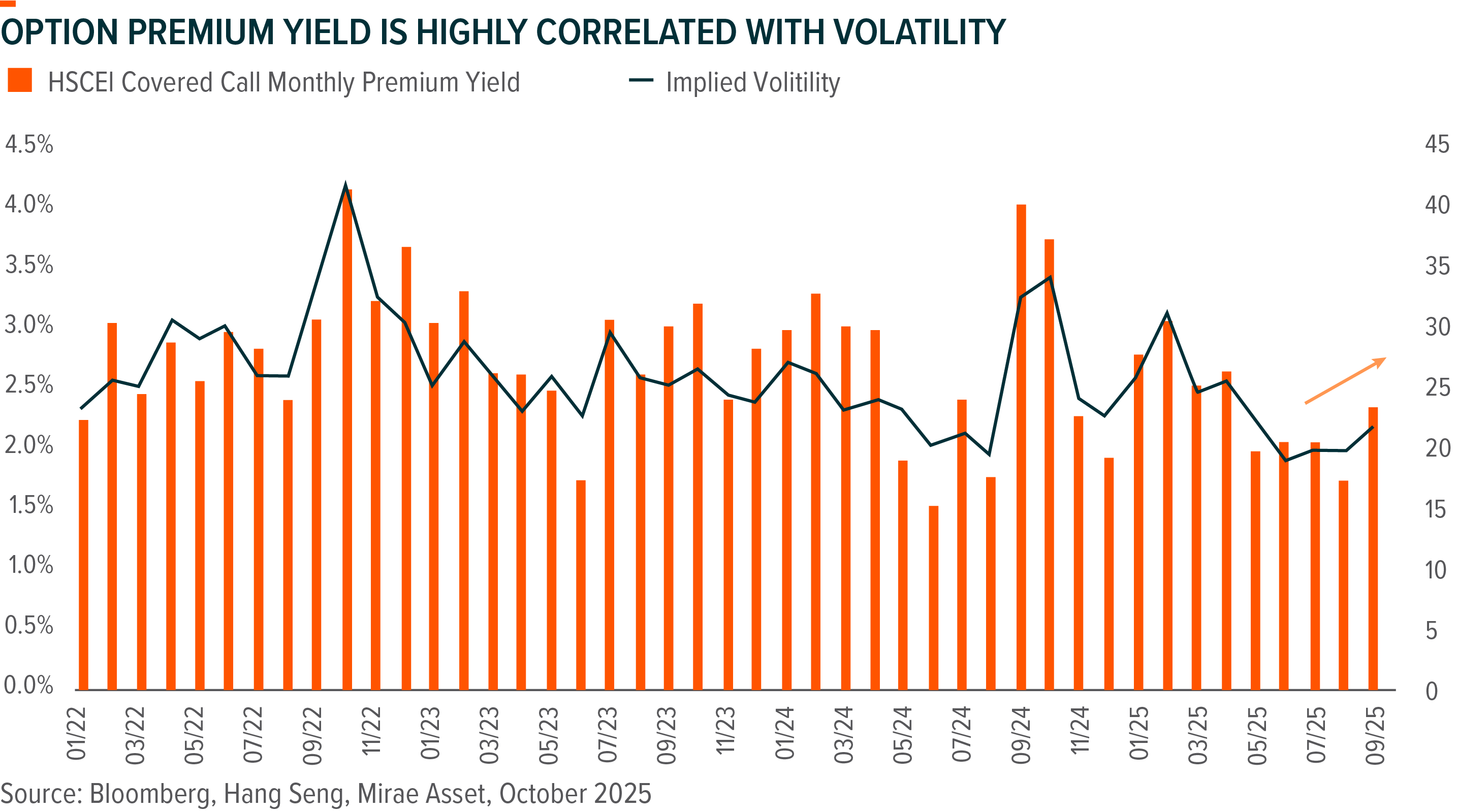
As the underlying index declines, the Covered Call Strategy also experiences a decrease, albeit to a lesser degree due to the partial protection offered by the option premium. In the last round of tariff negotiation in April, Global X Hang Seng TECH Covered Call ETF (3417) demonstrated resilience — experiencing a milder adjustment than the Hang Seng TECH Index and later recovering as market sentiment improved. As Global X Covered Call ETFs target to pay monthly dividend (Aim to Monthly Distribution. Dividend rate is not guaranteed, distributions may be made out of capital#) through selling monthly call option, the near-term correction could offer a favorable buying opportunity for these ETFs, potentially resulting in a higher monthly dividend yield.

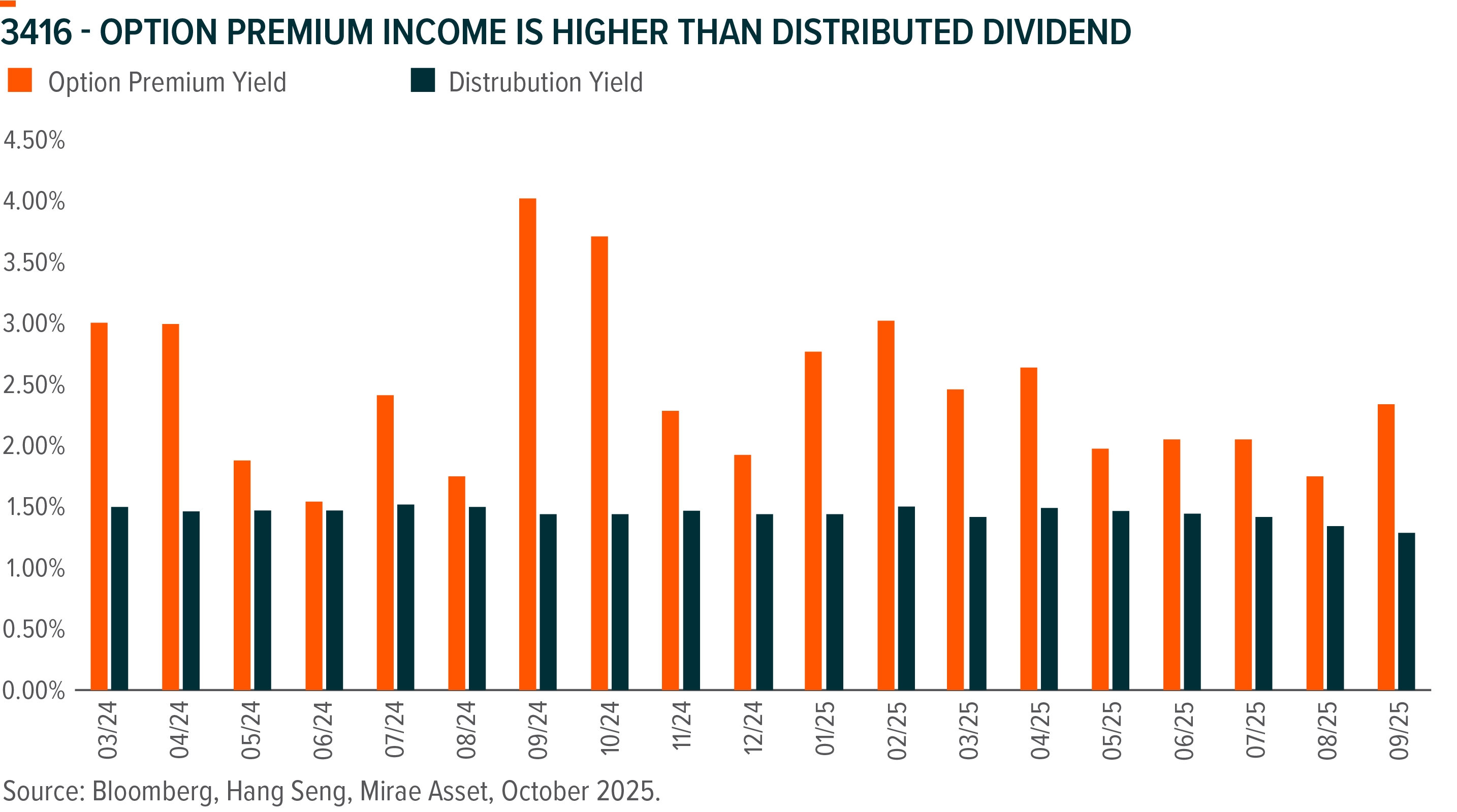
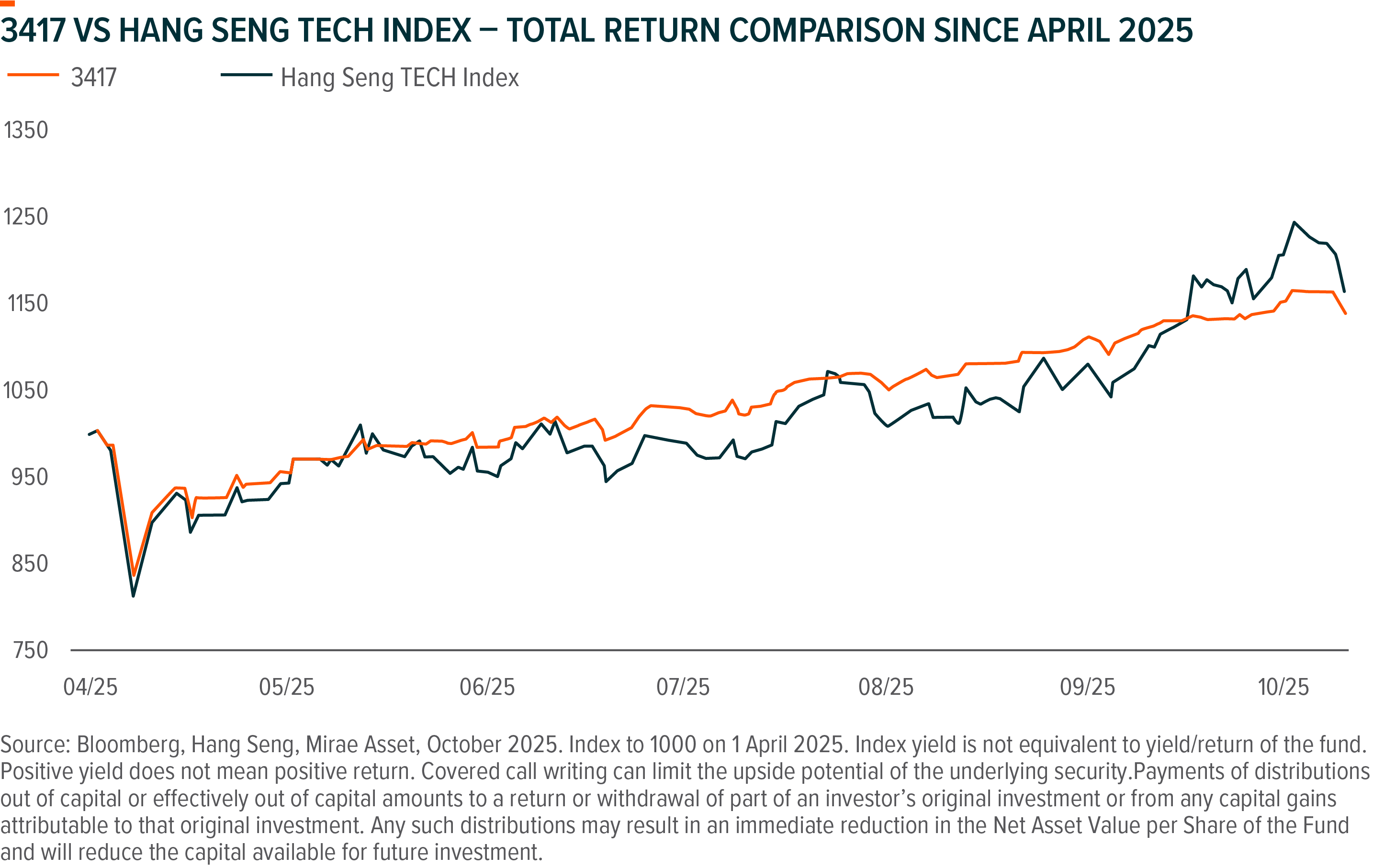
#Distribution is not guaranteed. Distribution may be made out of capital. Option premuim does not mean positive return or positive yield . Payments of distributions out of capital or effectively out of capital amounts to a return or withdrawal of part of an investor’s original investment or from any capital gains attributable to that original investment. Any such distributions may result in an immediate reduction in the Net Asset Value per Share of the Fund and will reduce the capital available for future investment. Total return is calculated based on price, with dividend reinvested. Past performance information is not indicative of future performance. Investors may not get back the full amount invested. Covered call writing can limit the upside potential of the underlying security. The Manager may at its absolute discretion declare distributions monthly to unitholders in each financial year and details of the distribution declaration dates, distribution amounts and ex-dividend payment dates will be published on the Manager’s website https://www.globalxetfs.com.hk/. Please refer to the prospectus of the fund to understand the distribution policy and other details. Investors should not base investment decisions on the above information alone. Please refer to the Prospectus(including Product Key Facts Statement) for details including the product features and the risk factors. Investment involves risks. Past performance is not indicative of future performance.
